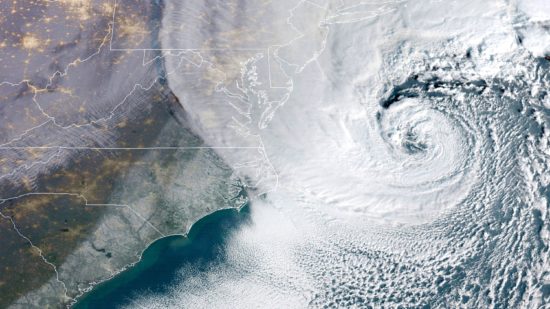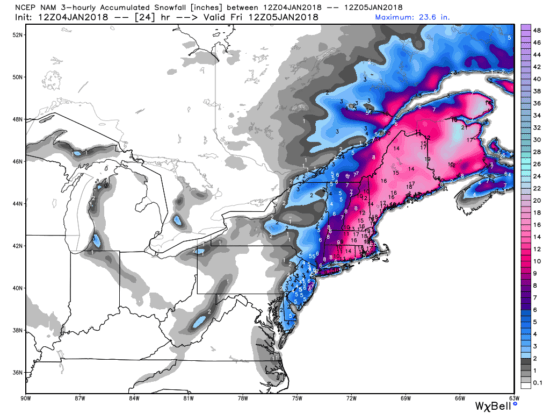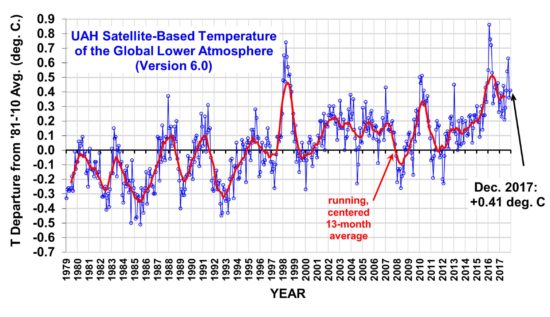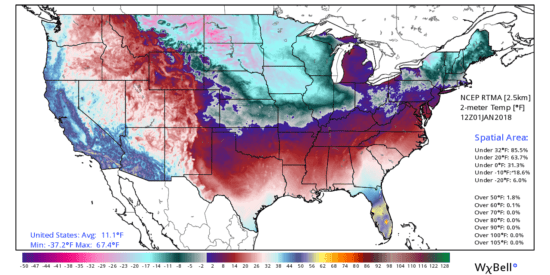It’s been an eventful weather week in some portions of the globe. In fact, it is always an eventful weather week – somewhere.
But what really drives the narrative is when weather extremes — which always have, and always will, occur — happen to hit major metropolitan areas. Many people are already aware of the relentless guffawing resulting from Al Gore’s tweet that Michael Mann says the Northeast’s current cold wave is just what global warming predicts. (As I recall, Mann is a mathematician, not a meteorologist. Correction: Mann is a geologist/geophysicist, which is equally uninformed on atmospheric dynamics.)
Yesterday, Kristine Phillips of The Washington Post wrote about the recent “bomb” snowstorm in New England, the ensuing cold wave, and the extreme heat (110+ deg. F) that has just hit Sydney, Australia.
To her credit, she did not explicitly put the blame on climate change for these events, but her legal-background prose came pretty darn close… just close enough so that the casual reader would make the connection. Wink-wink, nod-nod.
The trouble is that neither of these two events are exceptional from a meteorological perspective. That is, they have happened before (Sydney’s 117 deg. F peak was exceeded in 1939), and they will happen again.
It is only when we can demonstrate that such events are increasingly occurring over, say, 50 to 100 years that we can begin to invoke climate change. (And even then we must debate the various causes of climate change.) So far, that evidence is sorely lacking.
The Sydney Heat Wave
Here’s the GFS forecast model analysis of surface temperature departures from average for about the time that peak temperatures were reached in Sydney yesterday. Maybe you can tell me which of these cold and warm patterns are consistent with global warming theory and which aren’t? (Hint: Warming should be occurring basically everywhere):
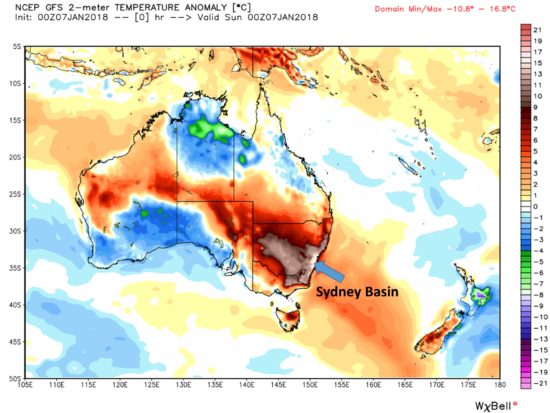
GFS analysis of surface temperature departures from normal at about the time 110 deg. F temperatures were reached in Sydney, Australia (Weatherbell.com graphic).
See that hotspot in the Sydney Basin? That is a localized effect of downslope winds from the highlands to the west which causes enhanced warming of the air, as well as bushfires. It clearly does not represent what is happening across Australia as a whole. Australia is exceedingly hot this time of year anyway, heat which is made even worse since the sun is closer to the Earth in January than in July (leading to a 7% range in solar radiation reaching the Earth).
The “Bomb” Blizzard
Meteorologist Fred Sanders coined the term “bomb” in 1980 to refer to a non-tropical cyclone whose central pressure drops by at least 24 millibars in 24 hours.
They happen every year.
But what doesn’t happen every year is them influencing major metro areas. So, the recent nor’easter snowstorm to hit the Mid Atlantic and New England was also a “bomb” because the low pressure center intensified so rapidly. These events happen every year in, for example, the North Atlantic and North Pacific.
We meteorologists used to talk about “bombs” fairly regularly in the 1980s, but not so much in recent years. I wonder if maybe climate change is making winter storms weaker? Hmmm…
And to attribute every winter cold wave or heat wave to global warming is just plain silly. These things happen even without global warming (which, by the way, I do believe is occurring, just not very strongly, dangerously, or maybe not even mostly due to human causation). Seasoned New Englanders can tell you that.
Meanwhile, The Weather Channel (aka “The Disaster Channel”) serves up a steady stream of weather porn to titillate the senses.
And before you believe that warmth in January is unusual, “January thaws” are a routine phenomenon, too, which is why the term was coined. According to the Glossary of Meteorology:
“The daily temperature averages at Boston, computed for the years 1873 to 1952, show a well- marked peak on 20-23 January; the same peak occurs in the daily temperatures of Washington, D.C., and New York City. Statistical tests show a high probability that it is a real singularity. The January thaw is associated with the frequent occurrence on the above-mentioned dates of southerly winds on the back side of an anticyclone off the southeastern United States.”
Nevertheless, the weird-weather-is-climate-change narrative will continue until the populace finally agrees with the warmongers that we can control our weather through taxation and regulation.

 Home/Blog
Home/Blog

